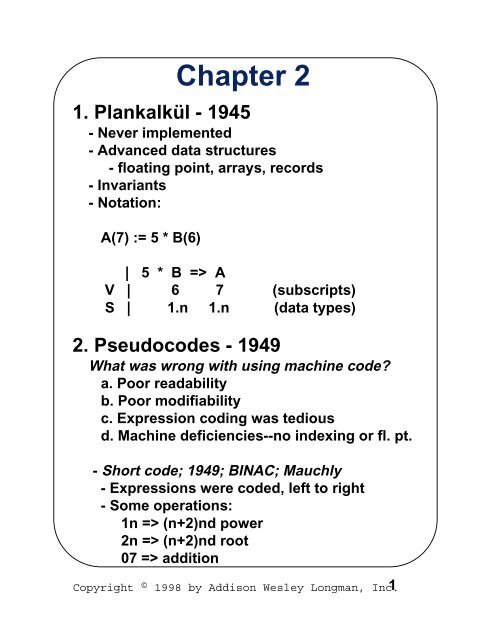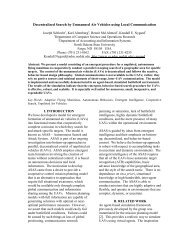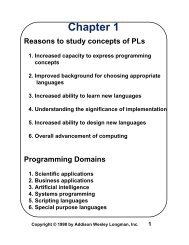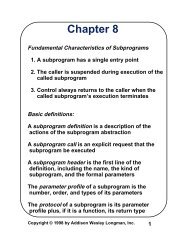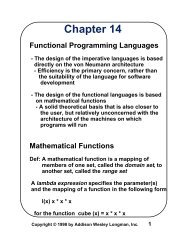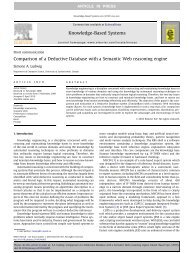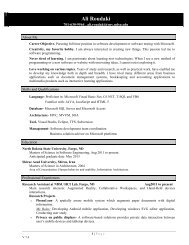2. Evolution of the Major Programming Languages. - NDSU ...
2. Evolution of the Major Programming Languages. - NDSU ...
2. Evolution of the Major Programming Languages. - NDSU ...
You also want an ePaper? Increase the reach of your titles
YUMPU automatically turns print PDFs into web optimized ePapers that Google loves.
Chapter 2<br />
1. Plankalkül - 1945<br />
- Never implemented<br />
- Advanced data structures<br />
- floating point, arrays, records<br />
- Invariants<br />
- Notation:<br />
A(7) := 5 * B(6)<br />
| 5 * B => A<br />
V | 6 7 (subscripts)<br />
S | 1.n 1.n (data types)<br />
<strong>2.</strong> Pseudocodes - 1949<br />
What was wrong with using machine code?<br />
a. Poor readability<br />
b. Poor modifiability<br />
c. Expression coding was tedious<br />
d. Machine deficiencies--no indexing or fl. pt.<br />
- Short code; 1949; BINAC; Mauchly<br />
- Expressions were coded, left to right<br />
- Some operations:<br />
1n => (n+2)nd power<br />
2n => (n+2)nd root<br />
07 => addition<br />
Copyright © 1998 by Addison Wesley Longman, Inc. 1
Chapter 2<br />
<strong>2.</strong> Pseudocodes (continued)<br />
- Speedcoding; 1954; IBM 701, Backus<br />
- Pseudo ops for arithmetic and math functions<br />
- Conditional and unconditional branching<br />
- Autoincrement registers for array access<br />
- Slow!<br />
- Only 700 words left for user program<br />
3. Laning and Zierler System - 1953<br />
- Implemented on <strong>the</strong> MIT Whirlwind computer<br />
- First "algebraic" compiler system<br />
- Subscripted variables, function calls, expression<br />
translation<br />
- Never ported to any o<strong>the</strong>r machine<br />
4. FORTRAN I - 1957<br />
(FORTRAN 0 - 1954 - not implemented)<br />
- Designed for <strong>the</strong> new IBM 704, which had index<br />
registers and floating point hardware<br />
- Environment <strong>of</strong> development:<br />
1. Computers were small and unreliable<br />
<strong>2.</strong> Applications were scientific<br />
3. No programming methodology or tools<br />
4. Machine efficiency was most important<br />
Copyright © 1998 by Addison Wesley Longman, Inc. 2
Chapter 2<br />
4. FORTRAN I (continued)<br />
- Impact <strong>of</strong> environment on design<br />
1. No need for dynamic storage<br />
<strong>2.</strong> Need good array handling and counting loops<br />
3. No string handling, decimal arithmetic, or<br />
powerful input/output (commercial stuff)<br />
- First implemented version <strong>of</strong> FORTRAN<br />
- Names could have up to six characters<br />
- Posttest counting loop (DO)<br />
- Formatted i/o<br />
- User-defined subprograms<br />
- Three-way selection statement (arithmetic IF)<br />
- No data typing statements<br />
- No separate compilation<br />
- Compiler released in April 1957, after 18 worker/<br />
years <strong>of</strong> effort<br />
- Programs larger than 400 lines rarely compiled<br />
correctly, mainly due to poor reliability <strong>of</strong> <strong>the</strong> 704<br />
- Code was very fast<br />
- Quickly became widely used<br />
5. FORTRAN II - 1958<br />
- Independent compilation<br />
- Fix <strong>the</strong> bugs<br />
Copyright © 1998 by Addison Wesley Longman, Inc. 3
Chapter 2<br />
6. FORTRAN IV - 1960-62<br />
- Explicit type declarations<br />
- Logical selection statement<br />
- Subprogram names could be parameters<br />
- ANSI standard in 1966<br />
7. FORTRAN 77 - 1978<br />
- Character string handling<br />
- Logical loop control statement<br />
- IF-THEN-ELSE statement<br />
8. FORTRAN 90 - 1990<br />
- Modules<br />
- Dynamic arrays<br />
- Pointers<br />
- Recursion<br />
- CASE statement<br />
- Parameter type checking<br />
FORTRAN Evaluation<br />
- Dramatically changed forever <strong>the</strong> way computers<br />
are used<br />
Copyright © 1998 by Addison Wesley Longman, Inc. 4
Chapter 2<br />
9. LISP - 1959<br />
- LISt Processing language<br />
(Designed at MIT by McCarthy)<br />
- AI research needed a language that:<br />
1. Process data in lists (ra<strong>the</strong>r than arrays)<br />
<strong>2.</strong> Symbolic computation (ra<strong>the</strong>r than numeric)<br />
- Only two data types: atoms and lists<br />
- Syntax is based on lambda calculus<br />
- Pioneered functional programming<br />
- No need for variables or assignment<br />
- Control via recursion and conditional<br />
expressions<br />
- Still <strong>the</strong> dominant language for AI<br />
- COMMON LISP and Scheme are contemporary<br />
dialects <strong>of</strong> LISP<br />
- ML, Miranda, and Haskell are related languages<br />
10. ALGOL 58 - 1958<br />
- Environment <strong>of</strong> development:<br />
1. FORTRAN had (barely) arrived for IBM 70x<br />
<strong>2.</strong> Many o<strong>the</strong>r languages were being<br />
developed, all for specific machines<br />
3. No portable language; all were machinedependent<br />
4. No universal language for communicating<br />
algorithms<br />
Copyright © 1998 by Addison Wesley Longman, Inc. 5
Chapter 2<br />
11. ALGOL 58 (continued)<br />
- ACM and GAMM met for four days for design<br />
- Goals <strong>of</strong> <strong>the</strong> language:<br />
1. Close to ma<strong>the</strong>matical notation<br />
<strong>2.</strong> Good for describing algorithms<br />
3. Must be translatable to machine code<br />
- Language Features:<br />
- Concept <strong>of</strong> type was formalized<br />
- Names could have any length<br />
- Arrays could have any number <strong>of</strong> subscripts<br />
- Parameters were separated by mode (in & out)<br />
- Subscripts were placed in brackets<br />
- Compound statements (begin ... end)<br />
- Semicolon as a statement separator<br />
- Assignment operator was :=<br />
- if had an else-if clause<br />
- Comments:<br />
- Not meant to be implemented, but variations<br />
<strong>of</strong> it were (MAD, JOVIAL)<br />
- Although IBM was initially enthusiastic, all<br />
support was dropped by mid-1959<br />
Copyright © 1998 by Addison Wesley Longman, Inc. 6
Chapter 2<br />
1<strong>2.</strong> ALGOL 60 - 1960<br />
- Modified ALGOL 58 at 6-day meeting in Paris<br />
- New Features:<br />
- Block structure (local scope)<br />
- Two parameter passing methods<br />
- Subprogram recursion<br />
- Stack-dynamic arrays<br />
- Still no i/o and no string handling<br />
- Successes:<br />
- It was <strong>the</strong> standard way to publish algorithms<br />
for over 20 years<br />
- All subsequent imperative languages are<br />
based on it<br />
- First machine-independent language<br />
- First language whose syntax was formally<br />
defined (BNF)<br />
- Failure:<br />
- Never widely used, especially in U.S.<br />
Reasons:<br />
1. No i/o and <strong>the</strong> character set made<br />
programs nonportable<br />
3. Too flexible--hard to implement<br />
4. Intrenchment <strong>of</strong> FORTRAN<br />
5. Formal syntax description<br />
6. Lack <strong>of</strong> support <strong>of</strong> IBM<br />
Copyright © 1998 by Addison Wesley Longman, Inc. 7
Chapter 2<br />
13. COBOL - 1960<br />
- Environment <strong>of</strong> development:<br />
- UNIVAC was beginning to use FLOW-MATIC<br />
- USAF was beginning to use AIMACO<br />
- IBM was developing COMTRAN<br />
- Based on FLOW-MATIC<br />
- FLOW-MATIC features:<br />
- Names up to 12 characters, with embedded<br />
hyphens<br />
- English names for arithmetic operators<br />
- Data and code were completely separate<br />
- Verbs were first word in every statement<br />
- First Design Meeting - May 1959<br />
- Design goals:<br />
1. Must look like simple English<br />
<strong>2.</strong> Must be easy to use, even if that means it<br />
will be less powerful<br />
3. Must broaden <strong>the</strong> base <strong>of</strong> computer users<br />
4. Must not be biased by current compiler<br />
problems<br />
- Design committee were all from computer<br />
manufacturers and DoD branches<br />
- Design Problems: arithmetic expressions?<br />
subscripts? Fights among manufacturers<br />
Copyright © 1998 by Addison Wesley Longman, Inc. 8
Chapter 2<br />
13. COBOL (continued)<br />
- Contributions:<br />
- First macro facility in a high-level language<br />
- Hierarchical data structures (records)<br />
- Nested selection statements<br />
- Long names (up to 30 characters), with hyphens<br />
- Data Division<br />
- Comments:<br />
- First language required by DoD; would have<br />
failed without DoD<br />
- Still <strong>the</strong> most widely used business<br />
applications language<br />
14. BASIC - 1964<br />
- Designed by Kemeny & Kurtz at Dartmouth<br />
- Design Goals:<br />
- Easy to learn and use for non-science students<br />
- Must be ”pleasant and friendly"<br />
- Fast turnaround for homework<br />
- Free and private access<br />
- User time is more important than computer time<br />
- Current popular dialects: QuickBASIC and<br />
Visual BASIC<br />
Copyright © 1998 by Addison Wesley Longman, Inc. 9
Chapter 2<br />
15. PL/I - 1965<br />
- Designed by IBM and SHARE<br />
- Computing situation in 1964 (IBM's point <strong>of</strong> view)<br />
1. Scientific computing<br />
- IBM 1620 and 7090 computers<br />
- FORTRAN<br />
- SHARE user group<br />
<strong>2.</strong> Business computing<br />
- IBM 1401, 7080 computers<br />
- COBOL<br />
- GUIDE user group<br />
- By 1963, however,<br />
- Scientific users began to need more<br />
elaborate i/o, like COBOL had; Business<br />
users began to need fl. pt. and arrays (MIS)<br />
- It looked like many shops would begin to<br />
need two kinds <strong>of</strong> computers, languages,<br />
and support staff--too costly<br />
- The obvious solution:<br />
1. Build a new computer to do both kinds <strong>of</strong><br />
applications<br />
<strong>2.</strong> Design a new language to do both kinds <strong>of</strong><br />
applications<br />
Copyright © 1998 by Addison Wesley Longman, Inc. 10
Chapter 2<br />
15. PL/I (continued)<br />
- PL/I contributions:<br />
1. First unit-level concurrency<br />
<strong>2.</strong> First exception handling<br />
3. Switch-selectable recursion<br />
4. First pointer data type<br />
5. First array cross sections<br />
- Comments:<br />
- Many new features were poorly designed<br />
- Too large and too complex<br />
- Was (and still is) actually used for both<br />
scientific and business applications<br />
16. Early Dynamic <strong>Languages</strong><br />
- Characterized by dynamic typing and dynamic<br />
storage allocation<br />
- APL (A <strong>Programming</strong> Language) 1962<br />
- Designed as a hardware description language<br />
(at IBM by Ken Iverson)<br />
- Highly expressive (many operators, for both<br />
scalars and arrays <strong>of</strong> various dimensions)<br />
- Programs are very difficult to read<br />
Copyright © 1998 by Addison Wesley Longman, Inc. 11
Chapter 2<br />
- SNOBOL(1964)<br />
- Designed as a string manipulation language<br />
(at Bell Labs by Farber, Griswold, and Polensky)<br />
- Powerful operators for string pattern matching<br />
17. SIMULA 67 - 1967<br />
- Designed primarily for system simulation<br />
(in Norway by Nygaard and Dahl)<br />
- Based on ALGOL 60 and SIMULA I<br />
- Primary Contribution:<br />
- Coroutines - a kind <strong>of</strong> subprogram<br />
- Implemented in a structure called a class<br />
- Classes are <strong>the</strong> basis for data abstraction<br />
- Classes are structures that include<br />
both local data and functionality<br />
18. ALGOL 68 - 1968<br />
- From <strong>the</strong> continued development <strong>of</strong> ALGOL 60,<br />
but it is not a superset <strong>of</strong> that language<br />
- Design is based on <strong>the</strong> concept <strong>of</strong> orthogonality<br />
- Contributions:<br />
1. User-defined data structures<br />
<strong>2.</strong> Reference types<br />
3. Dynamic arrays (called flex arrays)<br />
Copyright © 1998 by Addison Wesley Longman, Inc. 12
Chapter 2<br />
18. ALGOL 68 (continued)<br />
- Comments:<br />
- Had even less usage than ALGOL 60<br />
- Had strong influence on subsequent languages,<br />
especially Pascal, C, and Ada<br />
19. Pascal - 1971<br />
- Designed by Wirth, who quit <strong>the</strong> ALGOL 68<br />
committee (didn't like <strong>the</strong> direction <strong>of</strong> that work)<br />
- Designed for teaching structured programming<br />
- Small, simple, nothing really new<br />
- Still <strong>the</strong> most widely used language for teaching<br />
programming in colleges (but use is shrinking)<br />
20. C - 1972<br />
- Designed for systems programming<br />
(at Bell Labs by Dennis Richie)<br />
- Evolved primarily from B, but also ALGOL 68<br />
- Powerful set <strong>of</strong> operators, but poor type checking<br />
- Initially spread through UNIX<br />
21. O<strong>the</strong>r descendants <strong>of</strong> ALGOL<br />
- Modula-2 (mid-1970s by Niklaus Wirth at ETH)<br />
- Pascal plus modules and some low-level<br />
features designed for systems programming<br />
Copyright © 1998 by Addison Wesley Longman, Inc. 13
Chapter 2<br />
21. O<strong>the</strong>r descendants <strong>of</strong> ALGOL (cont.)<br />
- Modula-3 (late 1980s at Digital & Olivetti)<br />
- Modula-2 plus classes, exception handling,<br />
garbage collection, and concurrency<br />
- Oberon (late 1980s by Wirth at ETH)<br />
- Adds support for OOP to Modula-2<br />
- Many Modula-2 features were deleted<br />
(e.g., for statement, enumeration types, with<br />
statement, noninteger array indices)<br />
- Delphi (Borland)<br />
- Pascal plus features to support OOP<br />
- More elegant and safer than C++<br />
2<strong>2.</strong> Prolog - 1972<br />
- Developed at <strong>the</strong> University <strong>of</strong> Aix-Marseille,<br />
by Comerauer and Roussel, with some help from<br />
Kowalski at <strong>the</strong> University <strong>of</strong> Edinburgh<br />
- Based on formal logic<br />
- Non-procedural<br />
- Can be summarized as being an intelligent<br />
database system that uses an inferencing<br />
process to infer <strong>the</strong> truth <strong>of</strong> given queries<br />
Copyright © 1998 by Addison Wesley Longman, Inc. 14
Chapter 2<br />
23. Ada - 1983 (began in mid-1970s)<br />
- Huge design effort, involving hundreds <strong>of</strong> people,<br />
much money, and about eight years<br />
- Contributions:<br />
1. Packages - support for data abstraction<br />
<strong>2.</strong> Exception handling - elaborate<br />
3. Generic program units<br />
4. Concurrency - through <strong>the</strong> tasking model<br />
- Comments:<br />
- Competitive design<br />
- Included all that was <strong>the</strong>n known about<br />
s<strong>of</strong>tware engineering and language design<br />
- First compilers were very difficult; <strong>the</strong> first<br />
really usable compiler came nearly five years<br />
after <strong>the</strong> language design was completed<br />
- Ada 95 (began in 1988)<br />
- Support for OOP through type derivation<br />
- Better control mechanisms for shared data<br />
(new concurrency features)<br />
- More flexible libraries<br />
Copyright © 1998 by Addison Wesley Longman, Inc. 15
Chapter 2<br />
24. Smalltalk - 1972-1980<br />
- Developed at Xerox PARC, initially by Alan Kay,<br />
later by Adele Goldberg<br />
- First full implementation <strong>of</strong> an object-oriented<br />
language (data abstraction, inheritance, and<br />
dynamic type binding)<br />
- Pioneered <strong>the</strong> graphical user interface everyone<br />
now uses<br />
25. C++ - 1985<br />
- Developed at Bell Labs by Stroustrup<br />
- Evolved from C and SIMULA 67<br />
- Facilities for object-oriented programming, taken<br />
partially from SIMULA 67, were added to C<br />
- Also has exception handling<br />
- A large and complex language, in part because it<br />
supports both procedural and OO programming<br />
- Rapidly grew in popularity, along with OOP<br />
- ANSI standard approved in November, 1997<br />
- Eiffel - a related language that supports OOP<br />
- (Designed by Bertrand Meyer - 1992)<br />
- Not directly derived from any o<strong>the</strong>r language<br />
- Smaller and simpler than C++, but still has most<br />
<strong>of</strong> <strong>the</strong> power<br />
Copyright © 1998 by Addison Wesley Longman, Inc. 16
Chapter 2<br />
26. Java (1995)<br />
- Developed at Sun in <strong>the</strong> early 1990s<br />
- Based on C++<br />
- Significantly simplified<br />
- Supports only OOP<br />
- Has references, but not pointers<br />
- Includes support for applets and a form <strong>of</strong><br />
concurrency<br />
Copyright © 1998 by Addison Wesley Longman, Inc. 17


